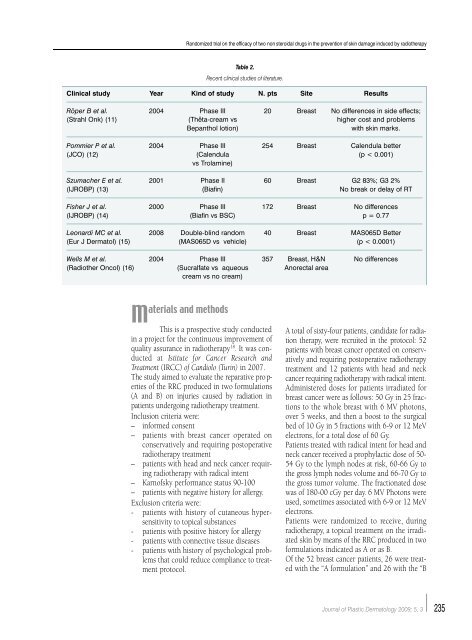Vol. 5, n. 3, September-December 2009 - Salute per tutti
Vol. 5, n. 3, September-December 2009 - Salute per tutti
Vol. 5, n. 3, September-December 2009 - Salute per tutti
You also want an ePaper? Increase the reach of your titles
YUMPU automatically turns print PDFs into web optimized ePapers that Google loves.
Randomized trial on the efficacy of two non steroidal drugs in the prevention of skin damage induced by radiotherapy<br />
Table 2.<br />
Recent clinical studies of literature.<br />
Clinical study Year Kind of study N. pts Site Results<br />
Rö<strong>per</strong> B et al. 2004 Phase III 20 Breast No differences in side effects;<br />
(Strahl Onk) (11) (Thêta-cream vs higher cost and problems<br />
Bepanthol lotion)<br />
with skin marks.<br />
Pommier P et al. 2004 Phase III 254 Breast Calendula better<br />
(JCO) (12) (Calendula (p < 0.001)<br />
vs Trolamine)<br />
Szumacher E et al. 2001 Phase II 60 Breast G2 83%; G3 2%<br />
(IJROBP) (13) (Biafin) No break or delay of RT<br />
Fisher J et al. 2000 Phase III 172 Breast No differences<br />
(IJROBP) (14) (Biafin vs BSC) p = 0.77<br />
Leonardi MC et al. 2008 Double-blind random 40 Breast MAS065D Better<br />
(Eur J Dermatol) (15) (MAS065D vs vehicle) (p < 0.0001)<br />
Wells M et al. 2004 Phase III 357 Breast, H&N No differences<br />
(Radiother Oncol) (16) (Sucralfate vs aqueous Anorectal area<br />
cream vs no cream)<br />
aterials and methods<br />
M<br />
This is a prospective study conducted<br />
in a project for the continuous improvement of<br />
quality assurance in radiotherapy 18 . It was conducted<br />
at Istitute for Cancer Research and<br />
Treatment (IRCC) of Candiolo (Turin) in 2007.<br />
The study aimed to evaluate the reparative pro p-<br />
erties of the RRC produced in two formulations<br />
(A and B) on injuries caused by radiation in<br />
patients undergoing radiotherapy tre a t m e n t .<br />
Inclusion criteria were:<br />
– informed consent<br />
– patients with breast cancer o<strong>per</strong>ated on<br />
conservatively and requiring posto<strong>per</strong>ative<br />
radiotherapy treatment<br />
– patients with head and neck cancer requiring<br />
radiotherapy with radical intent<br />
– Karnofsky <strong>per</strong>formance status 90-100<br />
– patients with negative history for allergy.<br />
Exclusion criteria were:<br />
- patients with history of cutaneous hy<strong>per</strong>sensitivity<br />
to topical substances<br />
- patients with positive history for allergy<br />
- patients with connective tissue diseases<br />
- patients with history of psychological problems<br />
that could reduce compliance to treatment<br />
protocol.<br />
A total of sixty-four patients, candidate for radiation<br />
therapy, were recruited in the protocol: 52<br />
patients with breast cancer o<strong>per</strong>ated on conservatively<br />
and requiring posto<strong>per</strong>ative radiotherapy<br />
t reatment and 12 patients with head and neck<br />
cancer requiring radiotherapy with radical intent.<br />
Administered doses for patients irradiated for<br />
breast cancer were as follows: 50 Gy in 25 fractions<br />
to the whole breast with 6 MV photons,<br />
over 5 weeks, and then a boost to the surgical<br />
bed of 10 Gy in 5 fractions with 6-9 or 12 MeV<br />
electrons, for a total dose of 60 Gy.<br />
Patients treated with radical intent for head and<br />
neck cancer received a prophylactic dose of 50-<br />
54 Gy to the lymph nodes at risk, 60-66 Gy to<br />
the gross lymph nodes volume and 66-70 Gy to<br />
the gross tumor volume. The fractionated dose<br />
was of 180-00 cGy <strong>per</strong> day. 6 MV Photons were<br />
used, sometimes associated with 6-9 or 12 MeV<br />
electrons.<br />
Patients were randomized to receive, during<br />
radiotherapy, a topical treatment on the irradiated<br />
skin by means of the RRC produced in two<br />
formulations indicated as A or as B.<br />
Of the 52 breast cancer patients, 26 were treated<br />
with the “A formulation” and 26 with the “B<br />
Journal of Plastic Dermatology <strong>2009</strong>; 5, 3 235

















